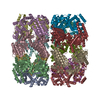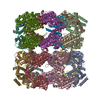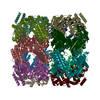+ Open data
Open data
- Basic information
Basic information
| Entry | Database: PDB / ID: 9c0b | ||||||||||||
|---|---|---|---|---|---|---|---|---|---|---|---|---|---|
| Title | E.coli GroEL + PBZ1587 inhibitor | ||||||||||||
 Components Components | 60 kDa chaperonin | ||||||||||||
 Keywords Keywords | CHAPERONE / GroEL / Inhibitor | ||||||||||||
| Function / homology |  Function and homology information Function and homology informationGroEL-GroES complex / chaperonin ATPase / mitochondrial unfolded protein response / protein import into mitochondrial intermembrane space / chaperone cofactor-dependent protein refolding / positive regulation of interferon-alpha production / isomerase activity / ATP-dependent protein folding chaperone / positive regulation of interleukin-6 production / positive regulation of type II interferon production ...GroEL-GroES complex / chaperonin ATPase / mitochondrial unfolded protein response / protein import into mitochondrial intermembrane space / chaperone cofactor-dependent protein refolding / positive regulation of interferon-alpha production / isomerase activity / ATP-dependent protein folding chaperone / positive regulation of interleukin-6 production / positive regulation of type II interferon production / unfolded protein binding / positive regulation of T cell activation / protein-folding chaperone binding / response to heat / protein refolding / ATP binding / metal ion binding Similarity search - Function | ||||||||||||
| Biological species |  | ||||||||||||
| Method | ELECTRON MICROSCOPY / single particle reconstruction / cryo EM / Resolution: 3.26 Å | ||||||||||||
 Authors Authors | Watson, E.R. / Lander, G.C. | ||||||||||||
| Funding support |  United States, 3items United States, 3items
| ||||||||||||
 Citation Citation |  Journal: J Am Chem Soc / Year: 2024 Journal: J Am Chem Soc / Year: 2024Title: Bis-sulfonamido-2-phenylbenzoxazoles Validate the GroES/EL Chaperone System as a Viable Antibiotic Target. Authors: Jack Godek / Jared Sivinski / Edmond R Watson / Felicidad Lebario / Wenli Xu / Mckayla Stevens / Christopher J Zerio / Andrew J Ambrose / Xiaoyi Zhu / Carlee A Trindl / Donna D Zhang / ...Authors: Jack Godek / Jared Sivinski / Edmond R Watson / Felicidad Lebario / Wenli Xu / Mckayla Stevens / Christopher J Zerio / Andrew J Ambrose / Xiaoyi Zhu / Carlee A Trindl / Donna D Zhang / Steven M Johnson / Gabriel C Lander / Eli Chapman /  Abstract: We recently reported on small-molecule inhibitors of the GroES/GroEL chaperone system as potential antibiotics against and the ESKAPE pathogens but were unable to establish GroES/GroEL as the ...We recently reported on small-molecule inhibitors of the GroES/GroEL chaperone system as potential antibiotics against and the ESKAPE pathogens but were unable to establish GroES/GroEL as the cellular target, leading to cell death. In this study, using two of our most potent -sulfonamido-2-phenylbenzoxazoles (PBZs), we established the binding site of the PBZ molecules using cryo-EM and found that GroEL was the cellular target responsible for the mode of action. Cryo-EM revealed that PBZ1587 binds at the GroEL ring-ring interface (RRI). A cellular reporter assay confirmed that PBZ1587 engaged GroEL in cells, but cellular rescue experiments showed potential off-target effects. This prompted us to explore a closely related analogue, PBZ1038, which is also bound to the RRI. Biochemical characterization showed potent inhibition of Gram-negative chaperonins but much lower potency of chaperonin from a Gram-positive organism, . A cellular reporter assay showed that PBZ1038 also engaged GroEL in cells and that the cytotoxic phenotype could be rescued by a chromosomal copy of GroEL/GroES or by expressing a recalcitrant RRI mutant. These data argue that PBZ1038's antimicrobial action is exerted through inhibition of GroES/GroEL, validating this chaperone system as an antibiotic target. | ||||||||||||
| History |
|
- Structure visualization
Structure visualization
| Structure viewer | Molecule:  Molmil Molmil Jmol/JSmol Jmol/JSmol |
|---|
- Downloads & links
Downloads & links
- Download
Download
| PDBx/mmCIF format |  9c0b.cif.gz 9c0b.cif.gz | 1.3 MB | Display |  PDBx/mmCIF format PDBx/mmCIF format |
|---|---|---|---|---|
| PDB format |  pdb9c0b.ent.gz pdb9c0b.ent.gz | Display |  PDB format PDB format | |
| PDBx/mmJSON format |  9c0b.json.gz 9c0b.json.gz | Tree view |  PDBx/mmJSON format PDBx/mmJSON format | |
| Others |  Other downloads Other downloads |
-Validation report
| Summary document |  9c0b_validation.pdf.gz 9c0b_validation.pdf.gz | 1.8 MB | Display |  wwPDB validaton report wwPDB validaton report |
|---|---|---|---|---|
| Full document |  9c0b_full_validation.pdf.gz 9c0b_full_validation.pdf.gz | 1.9 MB | Display | |
| Data in XML |  9c0b_validation.xml.gz 9c0b_validation.xml.gz | 186.5 KB | Display | |
| Data in CIF |  9c0b_validation.cif.gz 9c0b_validation.cif.gz | 281.9 KB | Display | |
| Arichive directory |  https://data.pdbj.org/pub/pdb/validation_reports/c0/9c0b https://data.pdbj.org/pub/pdb/validation_reports/c0/9c0b ftp://data.pdbj.org/pub/pdb/validation_reports/c0/9c0b ftp://data.pdbj.org/pub/pdb/validation_reports/c0/9c0b | HTTPS FTP |
-Related structure data
| Related structure data |  45078MC  9c0cC  9c0dC M: map data used to model this data C: citing same article ( |
|---|---|
| Similar structure data | Similarity search - Function & homology  F&H Search F&H Search |
- Links
Links
- Assembly
Assembly
| Deposited unit | 
|
|---|---|
| 1 |
|
- Components
Components
| #1: Protein | Mass: 57391.711 Da / Num. of mol.: 14 Source method: isolated from a genetically manipulated source Source: (gene. exp.)  Gene: groEL, groL, mopA, BN17_41231, BU34_16740, ECs5124, LF82_0923 Production host:  #2: Chemical | ChemComp-A1AS6 / Mass: 575.079 Da / Num. of mol.: 7 / Source method: obtained synthetically / Formula: C24H19ClN4O5S3 / Feature type: SUBJECT OF INVESTIGATION Has ligand of interest | Y | |
|---|
-Experimental details
-Experiment
| Experiment | Method: ELECTRON MICROSCOPY |
|---|---|
| EM experiment | Aggregation state: PARTICLE / 3D reconstruction method: single particle reconstruction |
- Sample preparation
Sample preparation
| Component | Name: E.coli GroEL + PBZ1587 inhibitor / Type: COMPLEX / Entity ID: #1 / Source: RECOMBINANT |
|---|---|
| Source (natural) | Organism:  |
| Source (recombinant) | Organism:  |
| Buffer solution | pH: 7.4 |
| Specimen | Embedding applied: NO / Shadowing applied: NO / Staining applied: NO / Vitrification applied: YES |
| Vitrification | Cryogen name: ETHANE |
- Electron microscopy imaging
Electron microscopy imaging
| Experimental equipment |  Model: Talos Arctica / Image courtesy: FEI Company |
|---|---|
| Microscopy | Model: FEI TALOS ARCTICA |
| Electron gun | Electron source:  FIELD EMISSION GUN / Accelerating voltage: 200 kV / Illumination mode: FLOOD BEAM FIELD EMISSION GUN / Accelerating voltage: 200 kV / Illumination mode: FLOOD BEAM |
| Electron lens | Mode: BRIGHT FIELD / Nominal defocus max: 1500 nm / Nominal defocus min: 500 nm |
| Image recording | Electron dose: 62.5 e/Å2 / Film or detector model: GATAN K2 SUMMIT (4k x 4k) |
- Processing
Processing
| CTF correction | Type: PHASE FLIPPING AND AMPLITUDE CORRECTION | ||||||||||||||||||||||||
|---|---|---|---|---|---|---|---|---|---|---|---|---|---|---|---|---|---|---|---|---|---|---|---|---|---|
| 3D reconstruction | Resolution: 3.26 Å / Resolution method: FSC 0.143 CUT-OFF / Num. of particles: 20659 / Symmetry type: POINT | ||||||||||||||||||||||||
| Refine LS restraints |
|
 Movie
Movie Controller
Controller






 PDBj
PDBj
